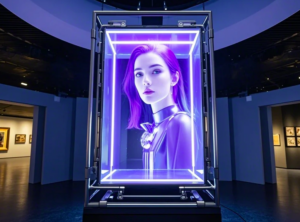目录
ToggleA 3D holographic display is a cutting-edge technology that fabricates the appearance of three-dimensional objects in real space, without the viewer needing to don special glasses or employ additional equipment. Unlike the conventional 2D screen, these displays use light diffraction to create a scene. The scene appears in three dimensions, with all the depth and realism one associates with actual objects in physical space. One can walk around a 3D holographic display, see the scene from a different angle, and still perceive it as three-dimensional.
How 3D Holographic Displays Work
The principles of light interference and diffraction govern how 3D holographic displays work. A digital image is projected through a set of optical elements—lasers, say, or lenses—that generate light patterns.
Why Are 3D Holographic Displays Important?
Engaging the learner in training and education can take many forms, but one of the most compelling may be the potential of  the 3D holographic display. This is a device that can project a three-dimensional image of an object that one can view from any angle. Imagine the next-generation Earth and space-sciences education that could be had if one could, in real-time, see the solar system with the planets rotating above one’s head. This is not Earth and space science “classroom, textbook, and lab coat” studying. This is Earth and space science study in a new, powerful, and unforgettable dimension. This powerful educational tool is not limited to the Earth and space sciences; it could also be very effective in the medical and entertainment industries and others as well.
the 3D holographic display. This is a device that can project a three-dimensional image of an object that one can view from any angle. Imagine the next-generation Earth and space-sciences education that could be had if one could, in real-time, see the solar system with the planets rotating above one’s head. This is not Earth and space science “classroom, textbook, and lab coat” studying. This is Earth and space science study in a new, powerful, and unforgettable dimension. This powerful educational tool is not limited to the Earth and space sciences; it could also be very effective in the medical and entertainment industries and others as well.
Applications of 3D Holographic Displays
Education: Visual Learning in School Teaching educators can bring lessons to life with holograms. Students can interact not only with historical figures but also with diagrams of atoms or models of ecosystems in a hands-on manner. They can use holo-grams to better grasp (as in fingering a guitar chord in the air) the three-dimensional shapes of molecules. And all this, as you know, is already happening. I love trying to think beyond just medicine, so let’s extend this a little.
Healthcare: A View into the Operating Room—Visualization is Everything In operating rooms, doctors may one day (or very soon) use holographic displays to visualize complex surgeries and practice on 3D models.
The Future of Holographic Technology
The way these patterns are generated, and the way they are thereafter manipulated, makes all the difference in allowing an “image” to mimic a real object naturally reflecting light. Increasingly, the “light” projected by these displays may even mimic the “light” one sees emanating from a real object, rather than a cover-up light as in many current displays; that is, the projected light will work in concert with the way real light does when it’s bouncing off a real object. If you work in an industry that uses light projection to create images, such as retail, medicine, or education, you might be trumpeting something soon.
Conclusion
Not only are 3D holographic displays fascinating to observe but also they can potentially revolutionize many industries. From education to healthcare to entertainment, our society has a multitude of impactful uses for this technology. And as it continues to develop, we can expect it to hold our attention and change our largely two-dimensional correspondence with the digital world. Prepare yourself for a future where your visual experience can be so much more than a flat screen!
0